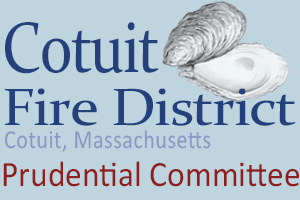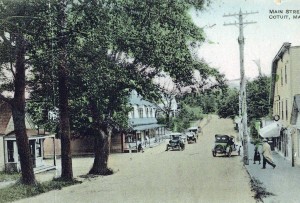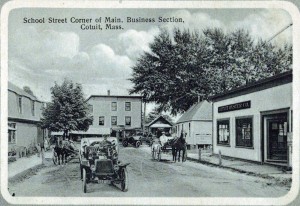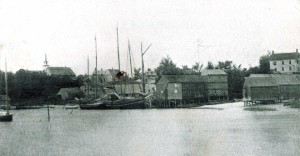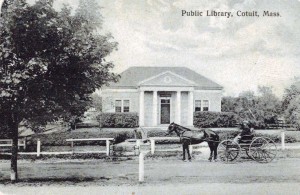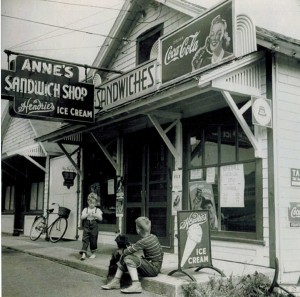Courtesy: Historical Society of Santuit and Cotuit
Written by: GORDON M. BROWNE, JR., July 14, 1967
In 1924, a fire in the center of Cotuit’s business district burned out two stores, destroyed three buildings, and severely damaged two others. In 1925, the Santuit House burned to the ground. In 1926 a fire badly damaged the handsome estate on Bluff Point. The Cotuit Fire Department, Cotuit Chemical Company Number 1, conscientious but handicapped by lack of equipment, had already begun a search for remedies to these disasters. In July of 1925 it had appointed a committee to investigate the establishment of a Cotuit Fire District. The history of Cotuit Chemical Company, written and read to the Historical Society in 1959 by E. Ormand Dottridge, Jr., records at this committee, named by Fire Chief Ernest 0. Dottridge, consisted of E. Ormand Dottridge, Jr., Freeman M. Nicker son, and Bertram F. Ryder.
Cotuit had so small a population that it could not legally form its own District without special enabling legislation passed by the Great and General Court of the Commonwealth of Massachusetts. The Fire Department committee, therefore, approached state representative Harry Albro. He introduced the necessary bill into the Massachusetts legislature, where it receive final approval on May 8, 1926.
There were six sections to this enabling act. Section 1 established the District in accordance with the lines of Precinct 7 of the Town of Barnstable as laid out in 1894 and subsequently revised. Section 2 authorized the District to purchase fire equipment, to provide hydrants and a water supply, to provide street lights and sidewalks, and to plan “for any other thing that may lawfully be done by said District” according to state law. Other sections gave the Prudential Committee the authority to hire policemen and watchmen, permitted the District to raise money by taxation, and detailed the procedure for calling the first meeting. The final section provided that the Act would take effect on acceptance by a majority of qualified voters voting at a meeting called for that purpose.
Under Section 5, the first meeting of the District would be called when five or more voters petitioned the Selectmen of the Town of Barnstable to call such a meeting and to prepare a warrant for it. The Fire Department committee wasted no time. A petition was presented to the Selectmen on June 1, 1926. Two of the signatories were Alexander Seabury Childs, who was ordered by the Select men to post notice of the first meeting, to be held on June 18, 1926, at Freedom Hall “at eight o’clock in the afternoon”, and E. Ormand Dottridge, Jr., who called the first meeting to order. The warrant was signed by Selectmen Edgar W. Lovell, Howard N. Parker, and William Lovell.
Attendance at that first meeting was slim. Only 28 voters cast ballots. After Ormand Dottridge had called the meeting to order and the warrant had been read, Calvin D. Crawford was elected temporary clerk from a list of eight nominees, and Alexander S. Childs was chosen Moderator. Then came the critical ballot on whether or not to accept the enabling legislation and actually establish the Cotuit Fire District. The final tally showed 22 affirmative votes, 6 negative. As of that moment, the Cotuit Fire District was a legal entity, those six doubters and several hundred absent voters notwithstanding.
By-laws for the new District had been prepared in advance and were now voted. They provided, among other things, that the Annual Meeting was to be held the second Monday in April and that all members of the Fire Department were to have framed copies of the by-laws hanging in their homes. This latter requirement is still among the official by-laws of the District. Ironically, at the District Meeting in 1967 a major complaint of the voters was that most people, in or, out of the Fire Department, had never seen a copy of the District by-laws.
After the adoption of by-laws in that first meeting, a recess was called to permit a nominating committee to prepare a slate of names for the first officers of the District. Though there is no record of who served on the nominating committee, older residents report that the names of a number of committee members appeared on the slate finally offered, a fact which may have been the basis for some of the personal frictions which intruded on District business in early years.
The first officers elected by the District were:
- Prudential Committee: Edgar W. Lovell, Ezra J. Gifford, and Calvin D. Crawford
- Clerk: Peter Campbell
- Treasurer: .Joseph Wendell Hamblin
- Chief Engineer: Thomas D. Rennie
- First Assistant Engineer: Milton H. Rocker
- Second Assistant Engineer: Freeman M. Nickerson
- Auditors: Ernest 0. Dottridge, Horace Nickerson, William H. Perry
The final business of the meeting was to direct the Prudential Committee and the Board of Engineers to investigate fire protection and its cost and to report to the next regular meeting.
There were two special meetings of the District in 1926. In August, the District voted to accept the equipment, buildings, and funds of the Cotuit Fire Department. Thus ended the existence of Cotuit Chemical Company Number 1. At that meeting, too, $1,000 was appropriated to cover all District expenses for the year. In September, the resignations of the Treasurer and the Chief Engineer were accepted. Herbert L. Snow was elected Treasurer, an office he was to hold from that time until his retirement at the 1967 Annual Meeting last February. The election for Chief Engineer was typical of the strong competition for that post which was to continue for many years. Alexander Seabury Childs was elected with 19 of the 38 votes cast. W. Christie Rennie received 18 and Milton H. Crocker 1. The results of this election were reversed at the following Annual Meeting when W. Christie Rennie was elected and reversed again in 1928 when Seabury Childs again became Chief. Such changes in the Board of Engineers have occurred more frequently than in any others of the District offices.
The pattern for handling the District’s business was set in that first year. There were subsequent shifts of the date of the Annual Meeting, first to the second Monday in March, then to the second Monday in January, and finally in 1938 to the present date, the second Monday in February. Occasional efforts were made to extend the scope of the District officers’ responsibilities. Perhaps the most ambitious was undertaken in 1929 when the voters approved a resolution offered by Calvin D. Crawford ordering that “the Moderator and Clerk appoint a Committee to consist of one man from the Oyster business, one from the Cranberry business, one connected with the summer people, a farmer, and one of the retail store men to study periodic unemployment in our District, and to derive means of overcoming it.”
As much as one might like to know the results of its deliberations, there is no record of this committee’s ever having issued a report. And though the feeling has often been expressed that the members of the Prudential Committee should act as the “town fathers”, the officers of the District have generally stayed close to their defined responsibilities of the enabling legislation, to provide fire protection, water, and street lights. For the purposes of this paper, it seems best now to consider these functions separately.
MISCELLANEOUS:
The handsome seal of the Cotuit Fire District was designed by Cotuit’s favorite artist, Reginald F. Bolles, and presented to the District at a special meeting in July of 1939. The framed original still hangs in Freedom Hall.
This District branched out into two other activities not provided for in its original enabling Act. Both of these were brought to the Annual Meeting in 1949. The Firemen’s Association felt the District should set up a World War II memorial in Memorial Park. Frederick Harlow and Calvin Crawford thought the financially hard-pressed Cotuit Library should have support from the District. The voters authorized the Prudential Committee to proceed with both these matters, which required special enabling legislation, In 1950, the District voted to accept Chapter 351, Acts of 1949, entitled “An Act authorizing Cotuit Fire District to raise and appropriate money for the benefit of the Cotuit Public Library and for the purchase of War Memorials in said District.” $1,000 was appropriated to purchase a suitable World War II memorial and to place it and the World War I memorial in the park. A special committee of William H. Perry, Jr., Antone R. Souza, Robert F. Hayden, John Botello, and I. Louis Campbell was appointed to see to this matter. An additional $200 was appropriated in 1951 to complete the work. At the same time an annual appropriation of $250 for the Cotuit Library was begun. In 1967 the figure was increased to $500.
One final word should be said about finances. The total expenses of the District in its first year of existence were $336.07. That was at a time when the voters were still wary of their new creation and especially of new taxes. As the years have passed, however, more and more services have been demanded of the District, and costs have risen inevitably. The Cotuit Fire District is the only district in the Town which owns and maintains a Hall – or which contributes to the local public library. It has one of the purest water supplies in the area and a strong fire department. It also has the smallest population of any district in the Town. As a result, taxes have gone up. As recently as 1947 the tax rate was only $2.90 per thousand, though it had been as high as $4.90 ten years earlier. By 1966 the rate was up to $8.00 and may go higher in 1967. The bonded indebtedness of the District has increased rapidly, especially as a result of Water Department construction. The one thing that has kept the tax rate from going completely out of bounds has been the steady -increase in the District property valuation. In 1937 the valuation was $2,620,690. Thirty years later, the 1966 valuation was $5,162,990, almost exactly twice as high.
There are two traditions of the Cotuit Fire District that come together here in discussing finances, traditions that might well be taken as summary comments on the whole history of the District. These are the traditions of service and frugality. The appendix of this paper lists all the officers of the District, and there one can see the names and years of service of many individuals who had as their chief concern the welfare of the community they all loved. And the records of their meetings and deliberations show clearly not only that love but also their Yankee sense of those things their community needed and of those things which they could get along without. Knowing which is which is still the problem every conscientious voter faces when the second Monday in February rolls around each year.
Prudential Committee
Moderator
| Edgar W. Lovell | 1926-1929 |
| Ezra J. Gifford | 1926-1937 |
| Calvin D. Crawford | 1926-1944 |
| Milton H. Crocker | 1930-1945 |
| Theron Apollonio | 1937-1942 |
| Frederick L. Harlow | 1943-1952 |
| Walter C. Scudder | 1944-1967 |
| Cecil Goodall | 1945-1950 |
| Robert F. Hayden | 1951-1963 |
| Joseph H. Beecher | 1952-1961 |
| Gordon M. Browne, Jr | 1961- |
| Robert S. Behlman | 1963- |
| Allan F. Crawford | 1967- |
Moderators are listed for Annual Meetings only. Quite often, especially in the early years of the District, a different Moderator was appointed for each special meeting.
Clerk
| Peter Campbell | 1926-1933 |
| Everett L. Hoxie | 1933-1937 |
| F. Maynard Gifford, Jr. | 1937-1966* |
*resigned in 1966 but was reelected.
Treasurer
| Joseph Wendell Hamblin | 1926* |
| Herbert L. Snow | 1926-1967 |
| Marjorie S. Greenwood | 1967- |
*resigned September 22, 1926
Auditor
| Ernest 0. Dottridge | 1926-1937 |
| Horace Nickerson | 1926-1930 |
| William H. Perry | 1926-1936 |
| Bertram F. Ryder | 1930-1960 |
| Charles N. Savery | 1936-1937 |
| Udell Perry | 1937 |
| Edward Bearse | 1937-1939 |
| John Newton | 1939-1941 |
| Edward Meacham | 1941-1950 |
| Theron Apollonio | 1951- |
| Joseph H. Beecher | 1961-1965 |
| Harry Crocker | 1965- |
Download a copy of the history of the Prudential Committee here
